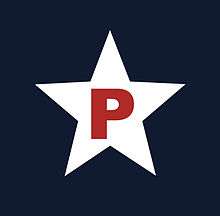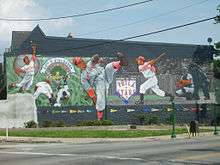44th and Parkside Ballpark
 | |
| Full name | P.R.R. YMCA Athletic Field |
|---|---|
| Location |
Southeast corner, 48th and Parkside Avenues Philadelphia, PA 19104 United States |
| Owner | Pennsylvania Railroad |
| Capacity | 6,000 |
| Field size |
Left - 330 ft. |
| Surface | grass |
| Construction | |
| Opened | May 2, 1903 |
| Expanded | 1920s |
| Tenants | |
|
Pennsylvania Railroad YMCA of Philadelphia, 1903-1905 Philadelphia Stars, 1934-1949 | |
The P.R.R. YMCA Athletic Field, also known as Penmar Park and commonly referred to in the 1930s and 1940s as the 44th and Parkside ballpark, was an athletic field and ballpark in West Philadelphia from 1903 to the early 1950s. It was built by the Pennsylvania Railroad YMCA. It was the home of the Pennsylvania Railroad YMCA of Philadelphia football club, often called the "Railroaders", from 1903 through 1905,[1] and the Philadelphia Stars Negro league baseball club from 1936 until 1952. The field was also used as a multi-sport athletic field used by the local community. During the 1930s the field was the site of home football games of Overbrook High School and St. Joseph's Preparatory School. Overbrook also played their home baseball games there. For example, the Philadelphia College of Pharmacy held 1906 Commencement Week "Athletic Games" at the field.[2] The independent Norfolk Black Bombers all-black barnstorming football team played the Washington Willow Trees on Thanksgiving Day 1942 at the park.[3] Stars co-owner Eddie Gottlieb organized a semi-professional baseball team called the "All-Phillies" which played at the field in its later years.[4]
The field first opened on May 3, 1903.[1] The ballpark itself was erected in the 1920s. Lights were added in 1933 to allow for night games.[5]
Behind the park's right-field fence stood the roundhouse of the main yard of the Pennsylvania Railroad.[6] Stars player Stanley Glenn would later recount how smoke and soot from the coal-powered trains would waft into the ballpark. Glenn recalls that the Stars would often stop their games until the smoke had cleared from the field.[7] Players recalled the field being rarely manicured resulting in the grass growing high.[8]
Ballpark capacity is said to have been 5,000[4] to 6,000 people. Overflow crowds would bring attendance up to 10,000.[9]
PRR Football
The Pennsylvania Railroad supported its employees through its sponsorship of the Pennsylvania Railroad YMCA. Philadelphia's Pennsylvania Railroad YMCA building was located at 41st Street and Westminster Avenue in West Philadelphia and was dedicated in 1894. Also that year, the YMCA began to sponsor the Pennsylvania Railroad's employee football team which had existed since 1886. This Railroad-YMCA team played against local college and athletic club teams. Players were former college players employed by the Railroad. (A similar club composed of players who worked for the Pennsylvania Railroad's "Panhandle Division" in Ohio would enter the National Football League as the Columbus Panhandles.) The "Railroaders" played home games until 1902 at a field at 52nd and Jefferson Streets. The YMCA opened their new field at Belmont and Parkside Avenues on May 2, 1903.[1]
Philadelphia Stars Baseball

The ballpark was owned by the Pennsylvania Railroad and Stars co-owner Eddie Gottlieb leased it from the Railroad for the club. The Stars played their home games at the ballpark with the exception of Monday nights when the Stars would play in North Philadelphia at Shibe Park, home of the Philadelphia Athletics and starting in 1938, the Philadelphia Phillies.[10]
Biographer Mark Ribowsky documented that Pittsburgh Crawfords catcher Josh Gibson hit a long home run in a game against the Stars early in the 1936 season that flew out of the ballpark.[11] The ballpark was home to another famous incident, in which Satchel Paige was working on a perfect game through eight innings. In the ninth, after three intentional walks, Paige was so sure of himself that he told his seven fielders to lie down on the field. Paige struck out the side on nine pitches.[5]
Negro League World Series games were often played at neutral game-sites to attract larger crowds. The Cleveland Buckeyes beat the Homestead Grays in game 4 of the 1945 Series at 44th and Parkside. Game 3 of the 1947 Series was also played at the Park in which the Buckeyes faced the New York Cubans.
Amazingly, the ballpark remained sturdy despite a woman named Miss Hattie Williams chopping wood from the grandstand with a hatchet most days. She used the wood as firewood to heat the washtub where she cooked the hot dogs for her concession stand behind home plate.[5]
Negro League Memorial Park and Mural
Today at 44th and Parkside is the Philadelphia Stars Negro League Memorial Park. In 2004, West Philadelphia's Business Association of West Parkside led a coalition of local groups in building the park. The Philadelphia Building Trades Council donated $150,000 in labor for construction.[12] A black-tie dinner was held on September 2, 2004 at the Mann Center for the Performing Arts, near the site of the ballpark, to raise money for the Memorial Park. The dinner honored former players Bill Cash, Stanley Glenn, Harold Gould, and Wilmer Harris.[13]
.jpg)
At the site of the Park are three tributes to the Philadelphia Stars and Negro Leagues' baseball in Philadelphia. There is a Pennsylvania Historic Site marker, a Negro Leagues Memorial Statue, and Philadelphia MuralArts program mural celebrating the Stars. The Stars Memorial Park and the Stars Mural straddle either side of Belmont Avenue as one crosses Parkside Avenue traveling west.
A Pennsylvania Historical marker was dedicated at Belmont and Parkside Avenues on April 25, 1998. The marker is titled, "African American Baseball in Philadelphia" and the text reads,
For 85 years, starting with the Pythians and Excelsiors in 1867, Black ball clubs were a significant part of the Philadelphia scene. The Giants, formed 1902, were soon "World's Colored Champions." The Hilldales, Eastern Colored League Champions, 1923-25, won the Colored World Series, 1925. The Philadelphia Stars from 1933-52; they were in the Negro National League, 1933-48, & many of their games took place at this site.[14]
Memorial Statue
A 7-foot high statue featuring a ballplayer following through on his swing stands in the Memorial Park. The Phillies hosted the dedication of the statue on June 18, 2003 at Veterans Stadium. Mayor John Street and Phillies shortstop Jimmy Rollins attended the unveiling of the statue, along with the then living members of the Stars, Bill Cash, Mahlon Duckett, Stanley Glenn, Harold Gould, and Wilmer Harris. The Phillies committed to pay for the maintenance and upkeep of the statue for a period of 10 years.[15]
The statue was unveiled and placed upon its pedestal at 44th and Belmont Avenues on April 15, 2005. Cash, Duckett, Gould, and Glenn all attended the ceremony. Wilmer Harris had died in December 2004. Phillies hitting coach Milt Thompson, whose father and grandfather played in the Negro Leagues, attended as did Rollins and former Phillies player Garry Maddox.[16]
The statue was sculpted by artist and Philadelphia native Phil Sumpter. Sumpter also designed the Judy Johnson statue at Wilmington's Frawley Stadium and a Roberto Clemente statue which stands at Third and Erie Streets in Philadelphia.[15]
Mural

Across Belmont Avenue from the Memorial Park is the mural "Philadelphia Stars: a tribute to Negro League baseball". The mural is part of the Philadelphia Mural Arts Program. It was painted by Philadelphia artist David McShane, and dedicated on September 19, 2006.[17] The mural has been described as an "impressionistic collage of scenes"; McShane consulted with surviving Stars players on their memories of the ballpark before creating the work.[8] The mural was sponsored by the Pennsylvania Horticultural Society's Philadelphia Green Program, the Philadelphia Department of Human Services, the Neighborhood Transformation Initiative, and the Business Association of West Parkside (which had also organized the creation of the Memorial Park). Former Stars players Glenn, Gould, Cash, and Duckett attended the dedication, as well as Phillies players Michael Bourn, Chris Roberson, and the artist McShane.[17]
See also
References
- 1 2 3 Fenton, John (2007). "Pennsylvania Railroad YMCA of Philadelphia, PA". Ghosts of the Gridiron. Retrieved 2009-01-13.
- ↑ Philadelphia College of Pharmacy Alumni Association (May 1906). "Field Day". Alumni Report. 42 (5): 113. Retrieved 2009-01-16.
- ↑ "Norfolk Pro Eleven Set for All Foes". The Afro American. 1942-11-17. p. 23.
- 1 2 Westcott, Rich (1996). Philadelphia's Old Ballparks. Philadelphia: Temple University Press. pp. 6, 7. ISBN 1-56639-454-6.
- 1 2 3 Lowry, Philip (2006). Green Cathedrals. Walker & Company and SABR. p. 178. ISBN 978-0-8027-1608-8.
- ↑ Riley, James A. (1994). The Biographical Encyclopedia of the Negro Baseball Leagues. New York: Carroll & Graf Publishers, Inc. p. 78.
- ↑ Glenn, Stanley (2006). Don't Let Anyone Take Your Joy Away: An inside look at Negro League baseball and its legacy. iUniverse, Inc. p. 29. ISBN 0-595-67777-0.
- 1 2 Strauss, Robert (2009-04-03). "Baseball all around; Our Phab Phils are back, and you can get into the game at museums, murals and more.". Philadelphia Inquirer. Retrieved 2009-04-06.
- ↑ Westcott, Rich (2001). A Century of Philadelphia Sports. Temple University Press. pp. 2, 3. ISBN 1-56639-861-4.
- ↑ Hochman, Stan (2004-08-03). "Five surviving Philly Stars, Negro leagues to be honored finally". Philadelphia Daily News. Retrieved 2009-01-13.
- ↑ Robowsky, Mark (2004). Josh Gibson: The Power and the Darkness. University of Illinois Press. ISBN 978-0-252-07224-6.
- ↑ Smith, Elmer (2004-10-06). "A memorial park for the original Philadelphia Stars". Philadelphia Daily News. Retrieved 2009-01-15.
- ↑ Hochman, Stan (2004-08-04). "Survivor of school of hard knocks". Philadelphia Daily News. Retrieved 2009-01-15.
- ↑ "African American Baseball in Philadelphia". Pennsylvania Historical and Museum Commission. Retrieved 2009-01-14.
- 1 2 "Phillies to unveil Negro League Memorial Statue". Philadelphia Phillies. 2003-06-10. Retrieved 2009-01-14.
- ↑ Santoliquito, Joseph (2005-04-15). "Philly Negro League stars honored". MLB.com. Retrieved 2009-01-14.
- 1 2 "Mural arts program dedicates Negro League mural: Philadelphia Stars Negro League team members and Phillies to gather at dedication". Philadelphia Phillies. 2006-09-18. Retrieved 2009-01-15.
Coordinates: 39°58′38″N 75°12′47″W / 39.9773°N 75.2130°W
External links
- philastarsmemorialpark.org
- Business Association of West Parkside/Philadelphia Stars Negro League Memorial Park
- Photograph of mural, "Negro Baseball League", at 4304 Parkside Ave.
- Gallery of photographs of mural and statue at 44th and Parkside Avenues.
- Review and Photos from BallparkReviews.com